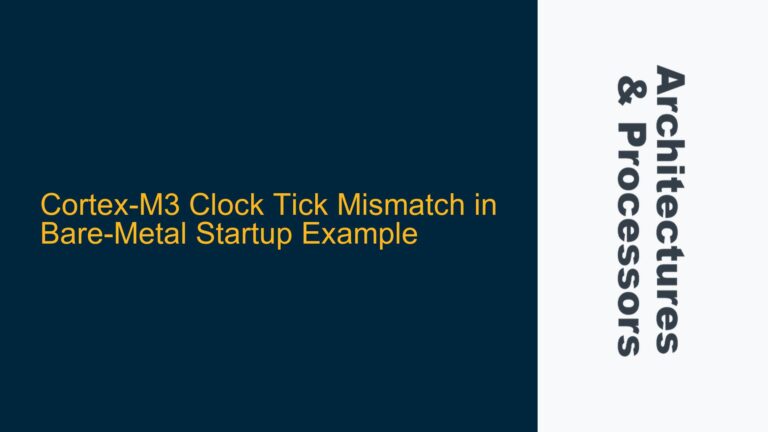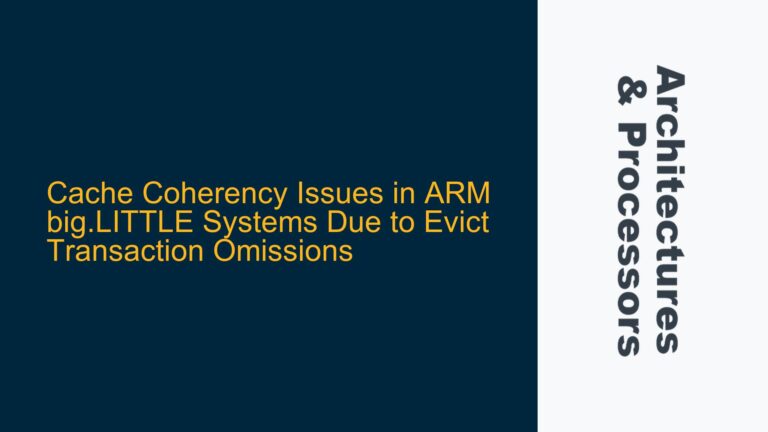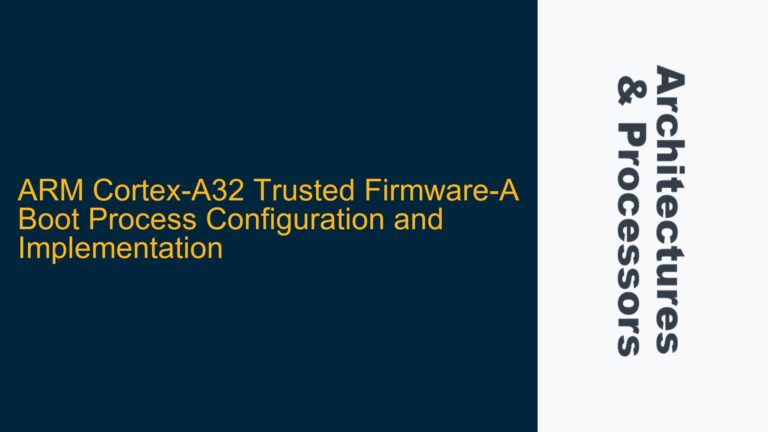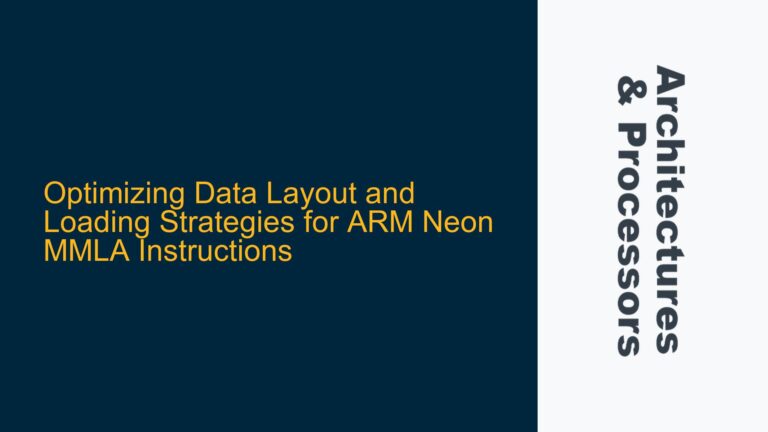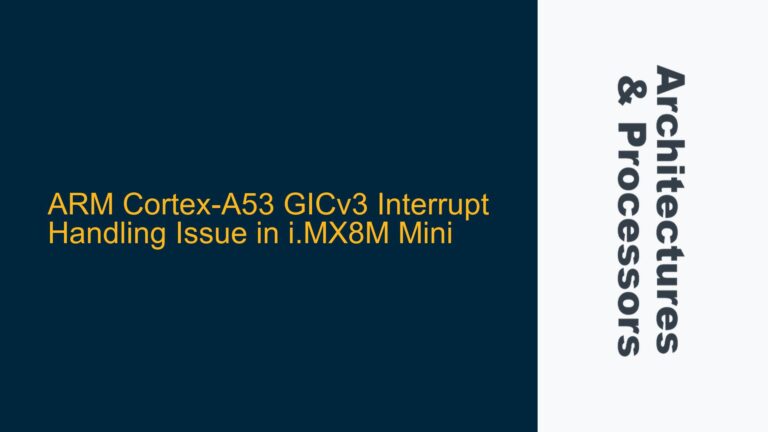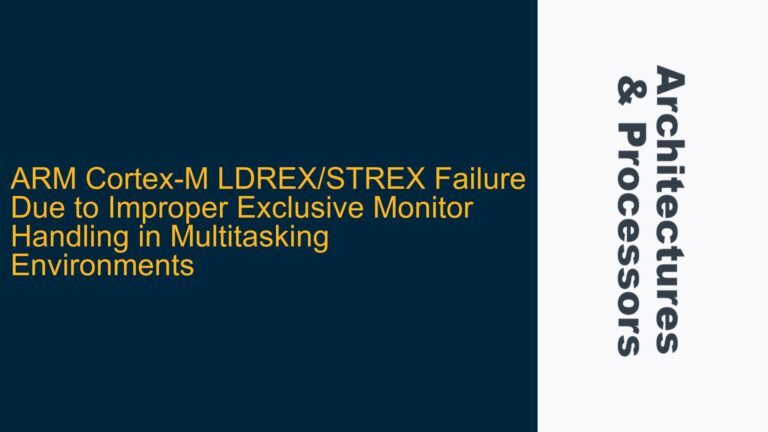ARM Cortex-M Reset Function Address Mismatch: VMA vs. LMA
The issue at hand revolves around the discrepancy between the Virtual Memory Address (VMA) and the Load Memory Address (LMA) of the Reset function in an ARM Cortex-M microcontroller. Specifically, the Reset function is placed in the .text section of the ROM, with an LMA of 0x00, but its VMA is 0x10. This mismatch can lead to confusion during the initialization and execution phases of the firmware, especially when dealing with bootloaders, memory-mapped peripherals, or complex linker scripts.
The VMA is the address where the code or data is expected to be during execution, while the LMA is the address where the code or data is stored in the binary image (e.g., in flash memory). In this case, the Reset function is stored at 0x00 in flash (LMA) but is expected to execute from 0x10 (VMA). This behavior is not inherently wrong but requires a deep understanding of the linker script, the memory layout, and the boot process of the ARM Cortex-M processor.
Linker Script Configuration and Memory Mapping
The linker script provided defines two memory regions: rom and ram. The rom region starts at 0x00 with a length of 256 bytes, and the ram region starts at 0x20000000 with a length of 16384 bytes. The .text section is mapped to the rom region with a VMA of 0x10 and an LMA of 0x00. This configuration implies that the .text section, which includes the Reset function, is stored at 0x00 in flash but is expected to execute from 0x10 in the memory map.
The key to understanding this behavior lies in the ARM Cortex-M boot process. Upon reset, the processor fetches the initial stack pointer value from 0x00000000 and the Reset vector (the address of the Reset function) from 0x00000004. However, the Reset function itself is placed at 0x10 in the VMA, which means the processor will jump to 0x10 after fetching the Reset vector. This setup is often used in scenarios where the first few bytes of memory are reserved for the vector table, and the actual code starts at a higher address.
The linker script snippet below highlights the relevant configuration:
MEMORY
{
rom (rx) : ORIGIN = 0x0, LENGTH = 256
ram (rwx) : ORIGIN = 0x20000000, LENGTH = 16384
}
SECTIONS
{
.text 0x10 : AT(0x00)
{
*(.text)
} >rom
}
Here, the .text section is assigned a VMA of 0x10 and an LMA of 0x00. This means the code is stored at 0x00 in flash but is expected to execute from 0x10 in memory. The AT(0x00) directive specifies the LMA, while the 0x10 before the colon specifies the VMA.
Boot Process and Vector Table Initialization
The ARM Cortex-M processor expects the vector table to be located at the beginning of the memory map. The first entry in the vector table is the initial stack pointer value, and the second entry is the Reset vector, which points to the Reset function. In this case, the Reset vector at 0x00000004 should contain the address 0x10, which is the VMA of the Reset function.
During the boot process, the processor performs the following steps:
- Fetch the initial stack pointer value from
0x00000000. - Fetch the Reset vector from
0x00000004. - Jump to the address specified in the Reset vector (
0x10in this case).
The Reset function then begins execution at 0x10. This setup ensures that the vector table is located at the beginning of the memory map, while the actual code starts at a higher address. This is a common practice in embedded systems to reserve space for the vector table and other critical data structures.
Debugging and Validating the Memory Layout
To validate the memory layout and ensure that the Reset function is correctly placed, you can use the following steps:
-
Inspect the Vector Table: Verify that the vector table is correctly populated with the initial stack pointer value and the Reset vector. The Reset vector should point to
0x10, which is the VMA of the Reset function. -
Disassemble the Binary: Use a disassembler to inspect the binary image and confirm that the Reset function is located at
0x10in the VMA. The disassembled output should show the Reset function starting at0x10. -
Check the Linker Map File: The linker map file provides detailed information about the memory layout, including the VMA and LMA of each section. Verify that the
.textsection has a VMA of0x10and an LMA of0x00. -
Simulate the Boot Process: Use a debugger or simulator to step through the boot process and confirm that the processor fetches the correct values from the vector table and jumps to the Reset function at
0x10. -
Validate the Linker Script: Ensure that the linker script correctly defines the memory regions and section placements. Pay special attention to the VMA and LMA assignments for the
.textsection.
Implementing Correct Memory Mapping and Boot Sequence
To implement the correct memory mapping and boot sequence, follow these guidelines:
-
Define the Vector Table: Ensure that the vector table is located at the beginning of the memory map. The first entry should be the initial stack pointer value, and the second entry should be the Reset vector pointing to the VMA of the Reset function.
-
Configure the Linker Script: Use the linker script to define the memory regions and section placements. Assign the VMA and LMA for each section, ensuring that the
.textsection has the correct VMA and LMA. -
Use Memory Barriers and Synchronization: If the code involves DMA transfers or other operations that require memory synchronization, use memory barriers and cache management instructions to ensure data consistency.
-
Test the Boot Process: Use a debugger or simulator to test the boot process and confirm that the processor correctly fetches the vector table and jumps to the Reset function.
-
Optimize for Performance: If the system has performance constraints, optimize the memory layout and code placement to minimize access latency and maximize execution speed.
By following these steps, you can ensure that the Reset function is correctly placed in memory and that the boot process proceeds as expected. This approach not only resolves the immediate issue but also provides a solid foundation for developing reliable and efficient embedded systems on ARM Cortex-M processors.
Conclusion
The mismatch between the VMA and LMA of the Reset function in the provided linker script is a deliberate configuration to accommodate the ARM Cortex-M boot process. By placing the vector table at the beginning of the memory map and the Reset function at a higher address, the system ensures a smooth boot sequence and proper initialization. Understanding the relationship between VMA and LMA, as well as the ARM Cortex-M boot process, is crucial for developing robust embedded systems. By validating the memory layout, debugging the boot process, and implementing correct memory mapping, you can avoid common pitfalls and ensure reliable system operation.

